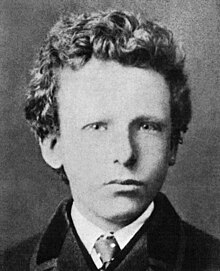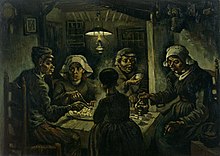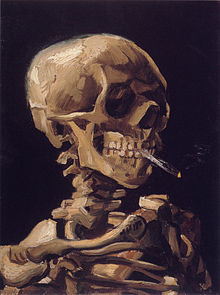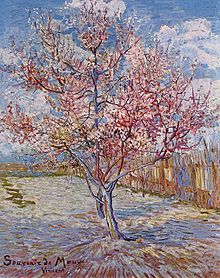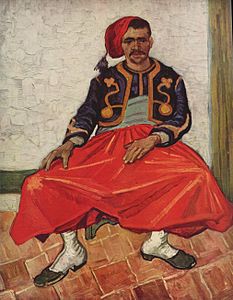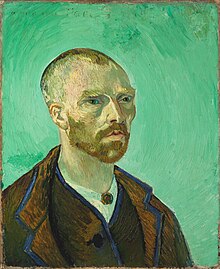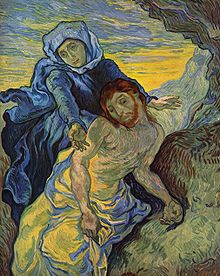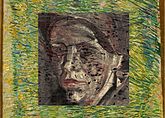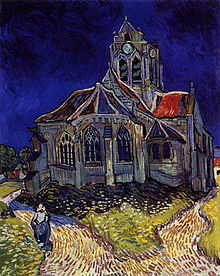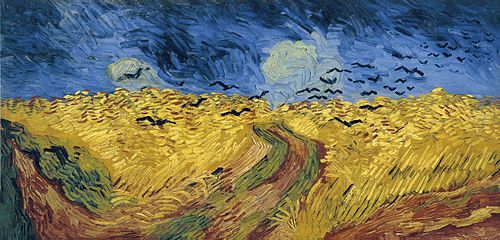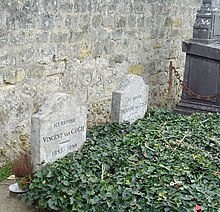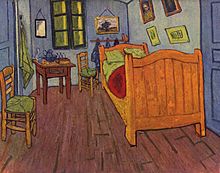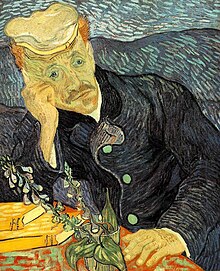Vincent van Gogh
Vincent Willem van Gogh (pronounced) ![]() [шv rayns imaginant fż ɣx] (?·i); Zundert, March 30, 1853-Auvers-sur-Oise, July 29, 1890) was a Dutch painter, one of the main exponents of post-Impressionism.
[шv rayns imaginant fż ɣx] (?·i); Zundert, March 30, 1853-Auvers-sur-Oise, July 29, 1890) was a Dutch painter, one of the main exponents of post-Impressionism.
He painted some 800 paintings (including 43 self-portraits and 148 watercolors) and made more than 1,600 drawings. A central figure in his life was his younger brother Theo, an art dealer in Paris, who provided him with continuous and selfless financial support. The great friendship between them is documented in the numerous letters exchanged since August 1872. Of the 800 surviving letters from the painter, some 650 were for Theo; the others are correspondence with friends and family.
Since he was young he had an inclination towards drawing. His first job was in an art gallery. He later became a Protestant pastor and in 1879, at the age of twenty-six, he went as a missionary to a mining region of Belgium, where he began drawing people from the local community. In 1885 he painted his first major work, The Potato Eaters. At that time his palette consisted mainly of somber and earthy tones. The light and preference for bright colors for which he is known arose later, when he moved to the south of France, achieving its fullness during his stay in Arles in 1888.
The quality of his work was recognized only after his death, in a retrospective exhibition in 1890, and he is currently considered one of the great masters in the history of painting. He greatly influenced 20th century art, especially among the German Expressionists and Fauves such as Matisse, Derain, Vlaminck, and Kees Van Dongen.He died at thirty-seven years of age from a gunshot wound; It is not yet known for sure if it was a suicide or an involuntary manslaughter. Although there is a general tendency to speculate that his mental illness influenced his painting, art critic Robert Hughes believes that the artist's works are executed under complete control; in fact, the painter never worked during the periods when he was ill.
Biography
Born on March 30, 1853, the son of an austere and humble Dutch Protestant minister named Theodorus and his wife Anna Cornelia, Vincent received the same name as a brother who was stillborn exactly one year earlier. On May 1, 1857, his brother Theo was born and they both had four more siblings: Cornelius Vincent, Elisabetha Huberta, Anna Cornelia and Wilhelmina Jacoba.
During childhood, he attended school intermittently and irregularly, as his parents sent him to different boarding schools. The first of them in Zevenbergen in 1864, where he studied French and German. Two years later he enrolled in the HBS Koning Willem II secondary school (Tilburg) living with the Hannik family at Sint Annaplein 18-19 and stayed there until he died. He left his studies permanently at the age of fifteen. It was then that his hobby for painting began.
About his childhood, Vincent van Gogh commented: "My youth was sad, cold and barren."
First works
Art dealer
From a very young age, he displayed a difficult character and a strong temperament. After dropping out and spending a year at Zundert, van Gogh began working in 1869, at the age of 16, as an apprentice at Goupil & Co. (later Boussod & Valadon), a major international art trading company from The Hague in which his uncle Vincent was a partner of his He adjusted to this new life quite well, coming to write:
It's a wonderful business. The longer you work on him the more ambitious you become one.
Four years later he was transferred to London to supply works of art to local businesses and it was there that he had his first contact with Eugenia, daughter of Úrsula Loyer, patron of the pension where he stayed. He fell in love with her, but the girl was engaged and rejected him.In 1874, a year after their stay in London, he spent family holidays in Helvoirt and confessed to her discomfort with Eugenia. He lived in isolation, reading religious books and losing interest in his work.
In May 1875, he was posted to Paris, where his love of art grew. At an exhibition of drawings by Jean-François Millet he commented:
When I entered the Drouot hotel room, where they were exposed, I felt something like: toss down because the ground that you tread is sacred.
On January 10, 1878, in a letter addressed to his brother Theo, he announced that he had been fired from the art gallery and that he would have to leave on April 1. The dismissal was due to personal preferences interfering about the sales to be made. However, at Boussod & Valadon was left with his brother Theo, four years his junior, who would work there from 1873 until his death and without whose dedication the short and intense artistic career of his older brother would never have been possible. His family proposed that he open a gallery himself, where he could offer the kind of painting he chose. He rejected the idea and later urged his brother, also an art dealer, to drop his work as "the art trade was a farce."
Religion
At the end of March 1876 he returned to England, where he stayed for two years. Around that time, Van Gogh increased his religious fanaticism. He was enthusiastic about reading the Bible, and The Imitation of Christ by Thomas of Kempis. After spending some time as an assistant teacher in Ramsgate, he began working in Isleworth as an assistant to the Methodist preacher Jones, where he even went to the pulpit of the church and read a sermon that he had scrupulously prepared. There is a copy of this first sermon that he sent to his brother Theo with phrases like:
When I was in the pulpit, I felt like someone from a dark underground cave comes out again in full light, and it is wonderful to think that from now on I will preach the Gospel all over the world.
He spent about six months in Dordrecht as a bookstore clerk, and in May 1877 he moved to Amsterdam where he wanted to become a theologian. He had to give up and also give up his desire to enter a Methodist school. He was rejected for not knowing Latin or Greek, and his difficulty speaking in public, although the reason was really his lack of subordination. It was increasingly difficult for him to adapt to a certain order and submit to someone who directed him.
In 1879, perhaps because of his deep fervor, he was sent as a missionary to the Mons region, to the Borinage mines in Belgium, where in extremely harsh conditions he carried out evangelizing work for twenty-two months among the miners in the area. But with his fanaticism, what he achieved was that they came to fear him. He slept in a small hut and his condition deteriorated more every day. In addition, he distributed among the poor what little he had. He said that he was obliged to believe in God to be able to bear so many misfortunes. His superiors then decided to send him to Cuesmes, spending a full year in absolute poverty and in contact with the miners, for whom he felt great sympathy:
The charcoalers and weavers still constitute a race apart from the other workers and craftsmen and I feel for them a great sympathy and I would feel happy if one day I could draw them, so that these still unpublished or almost unpublished guys were brought to light.
Then the small salary he received was abolished. Given all this, he followed the advice of his brother Theo, from whom he was already receiving financial help, and decided to change his life and dedicate himself to painting.
Painting: learning
Established in Brussels in 1880, he became friends with the Dutch painter Anthon van Rappard. He enrolled in the Academy of Fine Arts where he studied drawing and perspective. At this time he made sketches and drawings based on the paintings of Jean-François Millet, representing peasants and miners, models of daily life, and painting them very realistic and with dark tones.
Etten
On April 12, 1881, Vincent came to Etten to visit his brother. During this period he goes to the house of his cousin, the painter Anton Mauve, and where he falls in love again, this time with one of his cousins Cornelia Adriana Vos-Stricker (Kee), who had just been widowed, to whom he promptly proposed marriage, the Kee's response was: "No, never, never." Despite this refusal, he insisted through letters that the widow did not answer, in addition to refusing to see him. Vincent insisted with her parents, he went to her house to try to see her again, her relatives even told him that her insistence was "disgusting." In December 1881, he wrote to his brother, telling her the story and the disputes with his father:
But as you can see, I am again in The Hague; for Christmas I had a rather serious dispute with our father, who came to the extreme of telling me that it would be better for him to leave the house. He said it so energetic that I left that same day.
The Hague
| Drawings in The Hague | |
|---|---|
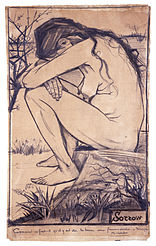 | 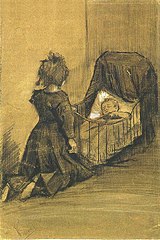 |
| Pena (1882). Possibly the model was Clasina Maria "Sien". | Knee girl in front of a crib (1883). |
In The Hague, his cousin Anton, a watercolor painter, advised him and insisted on the importance of learning perspective and drawing. Vincent then made his first watercolors and still lifes, using muted tones, as seen in the watercolors: The Poor and Money (1882) and Still Life with Cabbage and Clogs (1881).
Meanwhile, her love life took a new turn. Desperate after the rejection of his cousin Kee, or perhaps out of compassion, Vincent picked up Clasina María Hoornik (Sien), an alcoholic prostitute, pregnant and with a daughter, with whom he lived for a year; both his mother and daughter served as models for him. In the drawing Pain , in the lower margin, he quoted the words of Jules Michelet from the treatise La Femme (1860): «How is it that there is only one women?" Sien, due to lack of economic resources, had returned to prostitution and this, together with the great pressure Van Gogh suffered from his father, his brother Theo and his cousin Mauve (with whom he would argue and break his friendship), made this attempt at family life also fail.
After this relationship with Sien ended, he moved to Drenthe, in the north of the Netherlands, where he stayed for three months and painted landscape subjects in oil paint, in which one can appreciate the difference with the drawings made previously. Since he wanted to capture all the details, he made the oils with thick lines and thick brushstrokes. This season he felt loneliness more than ever; In the letters addressed to his brother, he urged her to give up her job as a dealer and follow the path of painting. In December 1883 he returned to his parents' home again, this time in Nuenen, where his father had been transferred.
Nuenen
In Nuenen he was well received by his family, who set up a room for him as a workshop, where he carried out works such as Princess garden in Nuenen in spring. In this period he dedicated himself to drawing and painting the work on the looms. He met a friend of his, Anthon van Rappard, whom he had met in Brussels and who had come to spend a few days in Nuenen. The two together studied and painted rural weavers. In these works, Van Gogh did not achieve the same technique as his friend, but he served as an example.
The painting The weaver at the loom, from May 1884, expresses the hardness and effort of this trade, but also the dignity of the character. Here Van Gogh demonstrates his solidarity and identification with the protagonist, trying to represent the ideal of a society free from industrialization and praises craftsmanship. The composition of this painting achieves the effect of framing the weaver in the mechanism of the loom, within a horizontal and vertical latticework that seems to integrate the character until it becomes part of the machine. The clarity of the background of the painting makes the whole drawing stand out.
In the autumn of 1884, he fell in love again, this time with a neighbour's daughter, Margot Begemann, ten years older than Vincent, who accompanied him on his pictorial outings in the countryside. They considered getting married, but were met with strong opposition from Margot's family, who even attempted suicide. Soon after, on March 26, 1885, Vincent's father died suddenly. Inheritance disputes between his mother and his sisters caused him to leave home to live in a larger place offered by a sacristan of the Catholic Church; in his family, who were Protestants, this fact was considered an offense.
During the spring of 1885 he painted what is considered one of his great early works: The Potato Eaters. Until then his efforts had always focused on the representation of a figure, but in this work he encountered the difficulty of having to coordinate five characters and manage to relate them. To make this painting he hired models, and made various sketch drawings of the figures and studies on details, with the hands holding the fork, cup or teapot. The earthy colors used did not contribute to a harmonious blend with the background.
In one of his letters he stated:
(...) I have consciously wished to express the idea that those people who, under the lamp, eat their potatoes with the hands that lie on the plate, have also worked the earth, and that my painting exalts, therefore, the manual work and the food that they themselves have gained so honestly (...).
With Theo's help, twenty lithographs of The Potato Eaters were printed, which people in the surrounding area were able to buy at affordable prices.
In a single day, he transferred directly onto the stone, from memory and without previous drawings, the image of The peasants eating potatoes (obviously, in the print on paper the figures are inverted). Of the twenty lithographs, Juliana Montford has managed to locate eight, among which is the one from the Thyssen-Bornemisza Museum.
This painting caused a break with his friend Rappard, as the hypersensitive and vulnerable Van Gogh did not accept his comments. Rappard made this criticism based on one of the 20 lithographs:
You will agree with me that this work cannot be taken seriously. Fortunately you're capable of much more. But why do you observe everything and treat it superficially, in the same way? Why don't you carefully study the movements? In this picture the characters pose. The woman's hand at the bottom... how unreal! And what's the relationship between the coffee maker, the table and the hand that plays the handle? What role does this coffee make? It doesn't hold, they don't hold it, so what? And why does the man on the right have no knees, no belly, no lungs? Or maybe he's got them on his back? Why is your arm missing a meter long, why is half the nose missing? Why does the woman on the left have a nose a pipe handle finished in a dice? And you still dare, with this way of working, to quote Millet and Breton? Art is too high to deal with such negligence.
It must be clarified that the harshness of van Rappard's criticism was also due to his own anger with Van Gogh, due to the fact that he had not received direct news of the sudden death of Vincent's father. At the beginning of this same letter, Rappard complained, offended at having received a simple note despite his friendship: "Did you think I had so little interest in your father and your family?" On seeing this painting in Paris, Camille Pissarro was deeply impressed by the expressive power of the painting. Émile Bernard also wrote in an article:
I was puzzled, in this confusion, by the food of the poor in a disturbing barrack under a mere light. He was great in his ugliness and was full of a disturbing life.
Presumably when Bernard spoke of grandiose ugliness, he was referring to colors, since he had a much more luminous sense of color.
During these two years in Nuenen he completed numerous drawings and watercolors, and nearly two hundred oil paintings. The colors used were still dark. His brother Theo complained, in one of his letters, that they were too subdued and were not in line with the style of the moment, where the brilliant paintings of the Impressionists stood out. Vincent wrote about it:
I have read with pleasure The old teachersFomentin. I have found "treated" in this book, in various places, the same issues that I was very concerned about these last times (...) try to give a clear value through relatively dark tones. In one word, express the light by opposition to the darkness. I know everything you think of "too black", but, however, I am not yet absolutely convinced (...).
The painting Still Life with Bible was painted in October 1885, before he left for Antwerp, in memory of his father who died on March 26 of that year. symbol of the paternal house and of a whole religious education. As a contrast appears La joie de vivre by Zola, the book of naturalism and, in the opinion of his father, one of the most disastrous works. In the composition, Van Gogh places the candle, a religious symbol, with the idea of placing both symbols at the same level.
Antwerp and Paris
In November 1885 Van Gogh arrived in Antwerp, where he took up a small studio above a paint shop; the rent was paid by his brother. He bought some Japanese woodcuts from some antique dealers, and dedicated himself to copying plaster models of ancient sculptures, exhibited at the then Royal Academy of Antwerp, despite his disagreement with academic teaching. He discovered the paintings of Rubens, which with their color and their feminine shapes opened up the alternative of using colors such as crimson and emerald green. At this time he contracted syphilis, which, although he was treated medically, caused him to lose almost all his teeth. In February 1886, he commented in letters to Theo that he had only been able to afford six or seven hot meals since the previous May.
In 1886 he moved to Paris, to live with his younger brother Theo, whom he warned with this simple note: «I will be at the Louvre from noon, or earlier, if you wish». Theo, who works at Boussod & Valadon, discovered to Vincent the works of impressionism; which produced a much more luminous palette, where color would play a fundamental role in the rest of his work. Over the next two years, the two brothers had multiple frictions and it always had to be Theo who gave in and forgave.
They settled in Montmartre and began to rub shoulders with the artists of the time who met there. He met Émile Bernard and Henri de Toulouse-Lautrec, becoming a great friend of them, as well as Paul Gauguin, Georges Pierre Seurat, Paul Signac, Armand Guillaumin, Camille Pissarro and Paul Cézanne. Van Gogh, like many painters of the time, admired the Japanese art of Hokusai, Hiroshige, and Utamaro. Proof of this are the replicas that he made of Japanese engravings and some of his paintings that reproduce that country in a scenographic way. Reproductions from Japan were called japonaiserie. Two of these works made by Van Gogh were Plum Blossoms and Bridge in the Rain, copies of works by Hiroshige. Of them, Van Gogh left the following comment:
I envy the Japanese for the incredible clarity of which all their works are impregnated. They never get bored or make the effect of having done them quickly... His style is as simple as breathing. They are able to make a figure with just a few secure strokes, which makes it look as easy as a snapping vest.
He began to use complementary colors and all this opened him up to an expression in his art that he had not suspected in the Netherlands. Pissarro also explained to him the new theories on light and the divisionist treatment of tones. The artist managed to gradually add richer and more luminous colors to his palette, thanks to Signac, with whom he worked in 1887. He practiced painting urban landscapes of the Montmartre district and still lifes with more vivid colors; the reds, yellows and blues with his complements can already be seen in almost all his paintings from this period.
Exalted by the intensity of the artistic climate in Paris, Van Gogh succeeded, with the help of Toulouse-Lautrec, in renewing his painting as far as psychological research into portraits is concerned. He was able to appreciate the exotic paintings made by Gauguin in Martinique. The portrait of Woman at the Café de Tambourin is from February 1887. It does not represent a drinker in any tavern but rather the specific image of Agostina Segatori, an old model for the painters Degas and Corot, and that at the time she was the owner of the café. The painting exudes a certain exotic appeal, from the woman's hairstyle through her dress to the background of the painting, where Japanese prints can be seen in its decoration. One of the most important things he learned at this time was the application of complementary contrast, contrasting the three basic colors (yellow, red and blue) to the mixture formed by the other two, such as a red-green, yellow-violet and blue-orange, which reinforce its tone or are neutralized when mixed with a dull gray. The application of this technique can be seen in the Four Sunflowers, where there is clearly a complementary contrast between the yellow and the vivid blue of the background.
Shortly before finishing his Parisian period, Van Gogh made three portraits of Julien Tanguy, called by all artists "Père Tanguy", in whose back room of his establishment Van Gogh, Gauguin, Cézanne and Seurat had exhibited their works. This portrait is considered the representative work of his Parisian period. With a frontal presentation, it is an image of a simple structure, which contrasts with the background decorated with Japanese prints. The Dutch artist was ready to realize his Mediterranean dream in search of the blinding light of Provence, with the explosion of nature and pure colours, colors that he had studied in his collection of Japanese prints. It was a very fertile period in which his art leaned towards impressionism, but on the other hand, absinthe and mental fatigue aggravated his physical condition.
Recent times: Arles
On February 21, 1888 Van Gogh arrived in Arles, in the south of France. He first settled in a room located in the Carrel Hotel-Restaurant, for which he paid five francs a day; This was beyond his economic possibilities and also the space was very small to have his workshop. He painted everything he saw (such as Flowering Orchard with views of Arles) and he no longer needed Japanese prints, as he himself admitted in a letter to his brother: «Here I don't need the Japanese art, because I imagine being in Japan and I just need to open my eyes and see what I have in front of me». The first paintings of him in Arles were typically Japanese; the painting Peach Tree in Blossom was made in March 1888.
He painted the surrounding nature, the wheat fields, the marshes of the Rhône delta and the canal south of Arles, which he reflected in various works, such as The Langlois Bridge. During this period he began to use the undulating brushstrokes and intense yellows, greens and blues that characterize his recent pictorial work.
Every year on May 24, gypsies from all over Europe make a pilgrimage to Saintes-Maries-de-la-Mer to venerate their patron saint, Sara la Negra. Van Gogh came to observe it and took the opportunity to make paintings during that time. Among these paintings is the work Barcas (fishing boats) in Saintes-Maries:
I spent a week in Saintes-Maries. On the sandy beach there were small green, red and blue boats, in shapes and colors so beautiful that they thought of flowers. They're so small they're almost never going to high seas. They come out when it does not wind and return to the ground when it blows too hard.Vincent van Gogh, June 1888.
The Van Gogh Museum announced on September 9, 2013 the discovery of a new work confirmed as a painting by Van Gogh: Sunset at Montmajour, made in Arles. Among the evidence that has been In order to detect its authenticity, there are two letters from Van Gogh addressed to his brother Theo dated July 1888 in which he describes the painting made:
Yesterday, at sunset, I was in a stony brezal where they grow very small and twisted oaks, at the bottom of a ruin on the hill, and wheat fields in the valley. It was romantic, it could no longer be to the Monticelli, the sun spilled, its yellow rays far above the bushes and the ground, absolutely a golden rain.Vincent van Gogh, Arles July 5, 1888 (Chart 636).
Portraits
At the beginning of his stay in Arles he dedicated himself to making portraits. However, he had a hard time getting someone to pose for him, especially if they were women; The first one he was able to portray was a young woman at the end of July, and he named her La Mousmé , a Japanese name that inspired him to read the book Madame Chisanthème , by Pierre Loti. With the men it was easier for him to convince them, since he in return invited them to a drink in the tavern. He could portray them without any problem, and so he made the works of The Peasant, portrait of Patience Escalier , The Zuau , Lieutenant Millet and The postman Roulin .
He had a good friendship with Joseph Roulin, a postman who was married to Mrs. Augustine Roulin and with whom he had three children: Marcelle, Armand and Camille Roulin. Vincent did a large number of paintings of this family; the portrait known as "La Berceuse" shows Mrs. Joseph Roulin; there are also the Portrait of Armand Roulin and the Portrait of Camille Roulin. He painted the postman up to six portraits.
The Portrait of Eugène Boch was made on the occasion of a visit that this Belgian poet made to him in July, as he explained to his brother. In this portrait he wanted to capture the romantic ideas of the character:
I have exaggerated the hair blond, I have also used orange and pale yellow tones. Behind the head, instead of painting the ordinary wall of the room, I have painted the infinity, a flat background of the richest and most intense blue I have ever been able to get and with this simple combination of the bright head on the intensely blue background I have achieved a mysterious effect, as if I were a star in the depths of a blue sky.Vincent van Gogh, July 1888
Gauguin's stay in Arles
Van Gogh spent the entire summer painting landscapes outdoors. To make the composition, he placed the entire architectural part in the background of the painting, with church towers, chimneys, houses, towns, in a thin strip at the height of the horizon, while the foreground was reserved for the fields and vegetation. He did this with the painting View of Arles with lilies in the foreground, The reapers with Arles in the background, The Harvest, Fields fields, The Green Vineyard and one of his best-known landscape works, The Sower, carried out in the month of June, when the harvest was almost ready, as can be seen in the ripe wheat field behind the planter. With the colors blue and purple and the shimmering yellows of the sun and the sky he achieved a chromatic contrast.
Van Gogh intended to create an artists' studio, and for this he rented in May the "yellow house" (so called because its exterior walls are painted that colour) on Place Lamartine, located north of the city of Arles. Theo sent him three hundred francs so that he could modestly arrange and furnish the house. The only one who responded to his request for the workshop was Paul Gauguin, with whom he had several letters on the subject of the Atelier du Midi that they would found together and which would request the participation of Seurat, Signac and Bernard.
Theo also urged Gauguin to make the trip to Arles. Gauguin lived at that time in Pont-Aven, in Brittany. He was full of debts, he felt misunderstood and he dreamed of founding a circle of painters, but surely he had not thought of Van Gogh as a member of it. His goal was to travel to Martinique, but the economic question was an impediment. that he did not decide to travel to Arles. This is how he made it known in a letter addressed to Émile Bernard, in October 1888:
As much as I appreciate it, I don't think Theo lends himself to keep me in the Midi just for my pretty face. With its cold Dutch character has studied the terrain and projects something...
He delayed the trip, apologizing by letter, until Theo finally paid off all Gauguin's debts. So, he traveled to Arles on October 23. Meanwhile, Vincent had made various series of paintings to decorate the house, especially the room for Gauguin.
The ideology of symbolism emerged in the late 19th century century. As Edouard Dujardin, one of the great theorists of this technique, wrote in 1886:
The aim of painting and literature is to reproduce the feeling caused by things with the media of the above-mentioned arts. What should be expressed is not the image but its character.
In the painting Jug with Twelve Sunflowers, painted in August 1888, Van Gogh searched for the spirit of symbolism. The meticulousness of the flowers contrasts with the chaotic situation of the leaves as well as the pasty application of color that, in front of the light blue background, gives the painting a meaning that goes beyond the simple reproduction of the flowers. It exposes the artist's imagination and his great expressive force, which required a great delusion of feelings.
During that month of August he made four paintings on sunflowers: first with three flowers, then with five, until he reached the one with twelve sunflowers on a blue background, and another with fifteen sunflowers on a yellow background.
Before Gauguin's arrival in Arles, he sent him a self-portrait, entitled Self-portrait as a bonze, a painting in which his identification with Japonism is evident, since he portrayed himself with bonzo-style shaved head.
Gauguin was the one who encouraged Van Gogh to paint historical places in Arles and so they worked together and painted the series of views of Alyscamps. They chose different motifs, Gauguin painted a landscape with a picturesque and rather refined charm, while Van Gogh chose a promenade framed by tall poplars that had a pure yellow color that contrasted with the blue-green of the sky. On the other hand, the color used by Gauguin was much more timid. They painted each other, Gauguin painted Van Gogh in profile and Van Gogh painted Gauguin from behind.
| Different views between Gauguin and Van Gogh | |
|---|---|
 |  |
| The Alyscamps (1888), by Paul Gauguin. | Alyscamps Avenue (1888), by Van Gogh. |
Cutting the ear
As the weeks went by, the coexistence of the two artists worsened, due to their personal differences, accentuated by the very temperamental nature of both. Less than two months later, on the afternoon of December 23, 1888, Van Gogh and Gauguin had an altercation that gave rise to one of the explanations that have been given about the loss of the former's left ear. Gauguin in his memoirs points out that Van Gogh threatened and chased him with a razor and that at night the Dutchman mutilated himself. Van Gogh then reportedly wrapped the ear in a cloth and went to a brothel in Arles that he frequented with Gauguin, where he presented this "gift" to a prostitute named Rachel. He subsequently returned to the "yellow house." The following morning the police found him unconscious, and he was transferred to the Hôtel-Dieu hospital in Arles.Theo was notified, and Vincent, who did not remember the event, was hospitalized for fourteen days. Gauguin left Arles for Paris and did not have contact with Vincent again, except for some later letters.
Gauguin told police that the loss of the auditory appendage was due to self-harm. The theory has been put forward that the cut in the ear was a self-mutilation by the artist as a result of his disgust at the news that his brother Theo was getting married.
There was never unanimity among scholars of the facts, due to the few existing sources and because the generally accepted version is based on Gauguin's memoirs, published in 1903. In 2009 Hans Kaufmann and Rita Wildegans, in their essay Van Goghs Ohr, Paul Gauguin und der Pakt des Schweigens (Van Gogh's Ear, Paul Gauguin and the Pact of Silence), reviewed the incident by studying the police report, published news in the newspapers of the time, the correspondence of the two painters and the few existing testimonies, much after the fact. They came to the conclusion that it was Gauguin who wounded Van Gogh with his saber in the dispute (he was a fencing master), and that once only Van Gogh would have finished cropping the ear. None of the weapons were found. Van Gogh would have said nothing to protect his friend, and Gauguin would have rushed back to Paris because of his bad conscience. Leo Jansen, curator at the van Gogh Museum in Amsterdam, rejects such a conclusion, stating that the evidence presented has been in most of it taken out of context.
For a long time it was believed that the artist had severed only part of his earlobe, not the entire appendage. However, a 2016 study presented, among other things, a letter to Theo van Gogh from Dr. Félix Rey, who treated him during the incident, describing the injury and accompanying a drawing showing that his ear was almost completely severed, conserving only a lower part of the lobe.
Upon returning home, Van Gogh painted the Self-portrait with Bandaged Ear, of which there are two versions. Both paintings show a bandage on the right side of the head, and must have been painted in front of a mirror, since the severed ear was the left. In one Van Gogh is depicted smoking a pipe to convey a sense of calm, in one composition in which both the chromatic balance and the balance of the iconographic elements predominate. After four weeks he was admitted to the hospital again as he presented symptoms of persecution mania and imagined that they wanted to poison him. For about ten days he was under treatment by Dr. Félix Rey. In March, in response to a request from the residents of Arles who notified the police, he was admitted once more, spending six weeks at the Hôtel-Dieu de Arles Hospital. On April 17, Theo married Johanna Bonger in Amsterdam. Soon after, Vincent decided to voluntarily enter the Saint-Paul-de-Mausole mental hospital, a former monastery in Saint-Rémy-de-Provence, about thirty-two kilometers from Arles.
Saint-Rémy-de-Provence Sanatorium
Van Gogh's last years were marked by his permanent psychiatric problems, which led him to be confined in voluntary mental hospitals, among which was the Saint Paul-de-Mausole asylum in Saint-Rémy-de -Provence, where he entered on May 8, 1889. In the sanatorium he had two rooms available, one of them used as a workshop. When he did not want to walk, for fear of suffering a crisis, he painted interior paintings, such as Vase with lilies. One of his first paintings there was Iris, where he shows great rhythmic vitality and a great conjunction of colors. At this time his painting is characterized by the presence of swirls, as can be seen in one of his best-known paintings, The Starry Night .
When he began to go for walks around the clinic, he created works where the subjects were pines, cypresses and olive trees. It was during the month of June that she developed the undulating pictorial effects on the trees. Of the olive trees with their sinuous trunks, she made several paintings: Alpilles with olive trees in the foreground , Olive Tree and Olive Harvesting . I had the pines as models in the same hospital garden. One of his first paintings was Undergrowth , where they can only be seen in the lower part of the trunks with tones made up of cold blues. Later he painted the pine trees that can be seen in the paintings: Saint Paul's Hospital Garden and Pines in the Evening Sky . But it was the cypresses, with their triangular shape, that helped him create a magnificent series of landscapes. He incorporated the dark stain of the cypress tree into many of his large compositions, such as The Starry Night and, among others, in Wheat Field with Cypress Trees, Cypresses with Two women and Cypress in the stellar sky.
In Saint-Rémy, he once again had the need to copy painters he admired, so he asked his brother Theo to send him reproduction sheets, from which he interpreted color in his own way. In this way he explored religious themes such as The Pieta (Delacroix), where he painted Christ with red hair and beard and The Raising of Lazarus (Rembrandt). He also returned to copy some of his favorite paintings, those of Millet: the Peasant Woman Beating the Flax and The Night (after La Veillée de Millet). All are kept in the Van Gogh Museum in Amsterdam.
Living exhibitions
The first exhibition of Van Gogh's work was in Paris in 1889, at the Salon des Indépendants, organized later (between May and October) than in other years, so that it could coincide with the World's Fair of that same year anus. The choice of works was made by the artists themselves but the new partners could only submit two, and Van Gogh indicated to his brother the two paintings he wanted to send: The Starry Night (1888) and Iris (1889).
In January 1890, he received an invitation to participate in an exhibition in Brussels with the group Les XX, to which he sent six works: two from the series The Sunflowers and four on landscapes. Two of which he had painted in Arles, The Red Vineyard and View of Arles , and two more in Saint-Rémy. During the inauguration, Henri de Groux criticized Van Gogh's paintings, but Toulouse-Lautrec and Paul Signac came out in his defense. In this same exhibition he sold the work The Red Vineyard , acquired by the painter belonging to the Los XX group Anna Boch, sister of her friend Eugène Boch.
Finally, it was at the Salon des Indépendants in Paris, in February 1890, where he exhibited the full quota of ten paintings.
He had new collapses again, which lasted longer than in the previous times; he suffered from anguish, terror and hallucinations with very intense rages. When she wrote back to Theo, she explained that she had decided to leave the clinic. After a brief stay in Paris with his brother, she decided to settle in Auvers-sur-Oise.
Auvers-sur-Oise
Transferred to Auvers-sur-Oise, a town near Paris, he settled in a room at the Ravoux inn. There he met a friend of Theo's, Dr. Paul Gachet, an amateur painter, who offered to look after him and visit him. Under the care of Dr. Gachet, Van Gogh's artistic activity was intense: in two months he painted more than seventy paintings. He frequented the doctor's house, and he painted the garden, his daughter Margarita surrounded by flowers and at the piano, and the doctor himself. Van Gogh took refuge in painting again with great enthusiasm, he liked the landscapes of Auvers, as they had previously amazed so many other painters such as Corot, Pissarro, Armand Guillaumin and Cézanne.
She wrote to her mother these reflections:
I am fully absorbed by these immense plains of wheat fields on a bottom of hills, vast like the sea, of a very tender yellow, a very pale green, of a very sweet malva, with a part of a labrated earth, all along with plantations of potatoes in flower; all under a blue sky with white tones, roses and violets. I feel very calm, almost too calm, I feel capable of painting all this.
It was in this town that he began to use the elongated double-square horizontal format, which had been used precisely in the Oise valley by the painter Charles-François Daubigny of the Barbizon school. Van Gogh had sometimes painted the garden of Daubigny's house.
His painting on The Church of Auvers-sur-Oise is built on strong, defined lines, giving the effect of a sculpture cut out against the deep blue of the sky, giving a sense of darkness. The depth is achieved with the two paths in the form of /v/ in the foreground; these paths appear placed in a similar way in a later work, Wheat Field with Crows. Van Gogh points out in his letters the loneliness and melancholy that these last landscapes of wheat fields have under stormy and threatening skies. The symbols of ravens hovering over the wheat have been said to suggest a premonition of death. The two bands of colour, contrasting blue and yellow, nullify the space of perspective. The composition of the perspective in the open field has an inverse sense, it leaves the horizon in the direction towards the front. The blue of the sky is on a single plane and manages to create a unit, while the yellow of the wheat is divided into two planes, the red of the roads in three and the complementary green of the stripes of the road in five. This painting is considered one of the artist's best works.
Antonin Artaud, with an extensive prose poem, gives the notion of Van Gogh's quality; just read some fragments of such a poem ("Van Gogh, the suicide by society"):
(...) Return to the crow box; who has seen how, in That one. painting, equals the land to the sea? (...) the sea is blue, but not of a blue water, but of liquid painting(...) Van Gogh has returned the colors to the Nature, but, to him, who will return them? (...) the one who knew how to paint so many suns embedded on so many subdued vines, the Café de Arlés, the collection of olives, the Alyscamps, where he (...)
Death
During the last thirty months of his life he produced 500 works and in his last 69 days he signed up to 79 paintings. On February 22, 1890, Van Gogh suffered a new crisis that was "the starting point of one of the saddest episodes in a life already plagued with sad events." This period lasted until the end of April, during which time he was unable to bring himself to write; however, he continued to draw and paint. Hughes writes that between May 1889 and May 1890, "he had fits of despair and hallucination which prevented him from working, and between them months in which he was able to do so and was marked by ecstasy." extremely visionary". However, his depression worsened and on July 27, 1890, at the age of thirty-seven, while walking in the countryside, he died. «I risked my life for my work, and my reason half destroyed»; these are Vincent's words in the last letter found on his deathbed on July 29, 1890. Vincent was buried in the Auvers-sur-Oise cemetery. His mental illnesses are considered to be a consequence of mental disorders which caused him kidney failure, probably due to kidney stones, although according to other authors his mental illness was caused by syphilis. Shortly after Vincent's death, his brother Theo was admitted to a clinic in Utrecht, where He died on January 25, 1891, six months after the death of his brother. In 1914 Theo's body was exhumed and buried next to Vincent's.
In 2011, a theory emerged that Van Gogh did not die naturally, but was accidentally shot by two boys playing with a gun. In a biography of the artist, Van Gogh: Life, Steven Naifeh and Gregory White Smith maintain that the shot came from René and Gaston Secrétan, two teenage brothers vacationing in Auvers, who were acquaintances of the painter, so he would not have wanted to incriminate them and would have blamed himself. According to the authors, René was a problematic boy who liked to dress as a "cowboy" and amused himself by shooting animals with an old 38-caliber pistol. Thus, on July 27, 1890, Van Gogh would have gone out to paint as usual, receiving accidentally shot the youngest of the brothers. According to Naifeh, a Princeton-trained art historian, "we reviewed the initial testimony that led to the suicide story, and we saw that it wasn't solid at all." This author affirms that in the interview that René Secrétan gave in 1956, the year of release of the film that Vincente Minnelli made about the Dutch painter, his testimony "is full of guilt." This theory is not confirmed by other evidence or accepted by the majority of the academic community, and the Van Gogh Museum in Amsterdam considers it premature to assess the conclusions reached by these authors.
Work
Vincent van Gogh produced all of his work (some 900 paintings and 1,600 drawings) over a period of only 10 years (1880-1890 period) until he succumbed to mental illness (possibly bipolar disorder or epilepsy). He decided to be a painter when he was twenty-seven years old and always wanted to reflect life in his works. His pictorial career is marked by the places where he lived and worked. This can be seen in the first stage of the Netherlands (1880-1886), where the traditional and popular painting of this country, exclusively in earthy colors, were what most influenced works such as The Potato Eaters and paintings about weavers. He made numerous drawings of miners, peasant figures and copied works by his favorite painter, Jean-François Millet.
Impressionism
The next stage, in Paris (1886-1887), is the one that puts him in contact with the impressionists who tried to break with the academicism of the time, with the transfer to painting of the impressions of his senses through observation of the nature. In Paris, he met painters such as Henri de Toulouse-Lautrec and Paul Signac, discovered a new perception of light and color, learned the division of light ranges and tones, and showed simplification as well as greater intensity in color. color treatment. At this time he began to copy Japanese prints, being one of the European painters most influenced by this type of painting.
Post-Impressionism
Van Gogh perhaps best represented Post-Impressionism, a style that occurred roughly in the period between 1885 and 1915. He represented a divergent path from Impressionism, where painters make everyday life their main subject. This term was used for the first time in 1910 by Roger Eliot Fry; It arises from the title he gave to the exhibition at the Grafton Gallery in London: "Manet and the Post-Impressionists." It was used by artists such as Cézanne, Van Gogh and Seurat but sometimes also by other artists of the great Impressionist decade (1870-1880) such as Matisse and Pierre Bonnard.
Expressionism and Fauvism
His work stands out for the use of color and a frenetic technique that contains some traces of expressionism. Van Gogh and Gauguin had different techniques: Gauguin used to paint normally in the studio from memory and Van Gogh always needed to copy in situ, whether it was landscapes or a model. His exalted temperament wanted to demonstrate it through color.
The beginnings of expressionism appear during the last two decades of the XIX century, in the work of Van Gogh, La Italiana at the end of 1887, and in that of Edvard Munch (author of The Scream) and, on another level, in that of the Belgian James Ensor (author of La entry of Christ into Brussels). A trend to which Van Gogh would contribute after his arrival in Arles in 1888, where the clash with the southern light pushed him to conquer colour, with works such as The Starry Night and The olive trees of Saint-Rémy (1889). Paintings from the Saint-Rémy de Provence period are generally characterized by swirls and spirals. The painter moves from the dramatization of the scenes of his first works to the simplification that characterized his last works, in which Van Gogh already announces the beginning of expressionism. He developed a style of strong drama and interior prospecting, and for this he used sinuous and dense brushstrokes, intense colors and strident luminosity, which distorted reality to the point of giving them a dreamlike air. However, we would have to wait until August 1911, when when the art critic Wilhelm Worringer was the first to speak of expressionism.
In Germany and Austria expressionists such as Ernst Ludwig Kirchner, Erich Heckel, Paul Klee and Oskar Kokoschka will learn from Van Gogh's technique, nervousness, the exaggeration of lines and colors, which make the expression of feelings emerge better and the emotions. The color and impasto in the projection of Van Gogh's painting was formalized fifteen years later with the rise of fauvism. According to Van Gogh: "Instead of accurately reproducing what I have in front of my eyes, I prefer to use color to express myself more powerfully."
Acknowledgments
Octavi Mirbeau, art historian, one of the first to admire Van Gogh, to pay homage to him at the Salon des Indépendants, in the exhibition held in 1891, wrote:
Here I find myself in the presence of someone great, great teacher, a person who disturbs me, excites me, draws my attention (...) Van Gogh possessed, in a rare way, something that differentiates a man from another: style (...) that is, affirmation of personality.
Since the XXI century, the analysis of the message that emerges from his paintings is positive and joyful. During his brief artistic dedication, Van Gogh achieved technical mastery and a productivity that few artists have achieved. In his works he managed to fuse the qualities of his Dutch predecessors, such as devotion to nature, with the use of color and the technique of French painting.
His fame grew rapidly after his death, thanks to the promotion of Theo's wife who, although she did not have a good relationship with Vincent, turned out to be the sole heir to all his work after the death of her husband, which occurred shortly after that of the painter. It should be noted that one of the few sales of Van Gogh during the artist's lifetime is due to her. The greatest impetus for his work came especially after an exhibition of 71 of his paintings held in Paris on March 17, 1901 (eleven years after his death) which was followed by other exhibitions, such as the one in 1905 in Amsterdam, or the Cologne in 1912, New York in 1913 and Berlin in 1914. All of these had a great impact on subsequent artistic generations. Since the middle of the century XX, Van Gogh was recognized as one of the greatest painters in history. In 2007, a group of Dutch historians produced The Canon of the Netherlands for their teaching in schools and included Van Gogh as one of the fifty subjects in the canon, along with other national icons such as Rembrandt and De Stijl.
The works sold during the painter's lifetime were limited to just three: The Red Vineyard, bought by Anna Boch for 400 francs; Clichy Bridge, purchased for 250 francs according to the sales book of the House of Boussod and Valadon; and, finally, a Self-Portrait to the London dealers Sulley and Lori. Curiously, the three works were bought in the same year of 1888.
Several of Van Gogh's paintings are among the highest paid paintings in the world. On March 30, 1987, Van Gogh's painting Lilies was sold for a record value of $53.9 million at Sotheby's in New York. magnate Alan Bond, could not finish paying it off and had to resell it (for an undisclosed sum) to the Getty Center in Los Angeles. On May 15, 1990, his Portrait of Doctor Gachet was sold for $82.5 million at Christie's, setting a new record price. The Imagine Van Gogh exhibition is a series of screens that simultaneously allow the viewer to be immersed in a selection of large-sized works by the author projected from different angles.
Work procedures
The technique he used was different depending on the effect he wanted to achieve, he covered the planes with light colors, while in other paintings he put broad brushstrokes and sometimes outlined the entire drawing with thick strokes. On other occasions, he would work with a hard brush, scratching all the shapes, and depending on what interested him, he would accentuate the lines or the color. The line with rhythmic movement was repeated in both drawings and paintings.
Van Gogh is believed to have repurposed canvases already used for more than a third of his output during his early work. In 2008, a team from Delft University of Technology and the University of Antwerp used advanced X-ray techniques X to discover a previously painted image of a woman's face and even get its coloring, which was located below the Grass Stain artwork.
Works
- Young man cutting grass with a sickle (1881), rounded paper, charcoal and water colour, Kröller-Müller Museum, Otterlo
- Authorport (1887), oil on canvas, Chicago Art Institute
- Authorport (1888), oil on canvas dedicated to Paul Gauguin, Fogg Museum of Cambridge, United States
- Author portrait (1889), oil on canvas, Washington National Art Gallery
- Self-portrait with the ear bandaged and cavalette (1889), oil on canvas, Gallery of the Somerset House
- Almond in flower (1890), oil on canvas, Van Gogh Museum, Amsterdam
Theft of his paintings
Van Gogh's paintings have been stolen since World War II. Some of his works have not been recovered. In 2002 thieves stole 2 of the paintings from the Van Gogh Museum, Scheveningen Beach During a Storm (1882) and Congregation Leaving the Reformed Church in Nuenen (1884-1885), which were found in Italy in 2016.
Letters
Much of the knowledge about van Gogh derives from his letters, most of them addressed to his brother, Theo van Gogh. More than six hundred letters from Vincent to Theo and forty letters from Theo to Vincent, and although most of them are undated, art historians have been able to arrange this correspondence largely chronologically. The compilation of these textual sources has been very valuable in establishing the bases of what is known about the Van Gogh brothers. It is interesting to note that the period in which Van Gogh's life is darkest is his period in Paris, since Theo and Vincent lived together without having to write to each other and therefore there is less information.
Van Gogh corresponded and there are some two hundred letters addressed to friends and relatives, especially to his sister Wilhelmina. The letters came to light in 1913, through his brother Theo's widow, Johanna van Gogh-Bonger, who he explained the "unease" he felt when showing the drama of the painter's life and his concern that it not be a reason to overshadow his artistic work. Van Gogh himself had been an avid reader of biographies of other artists to check the consonance of character with their art.
Contenido relacionado
The seven samurai
Romansh
Silly

